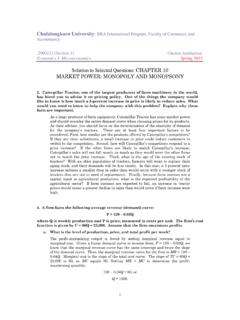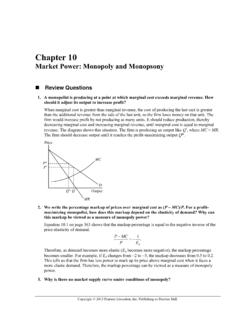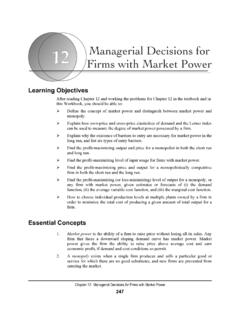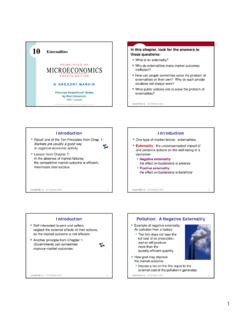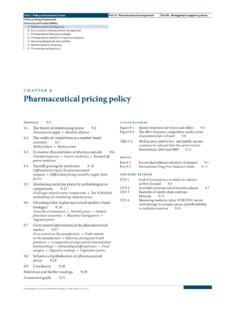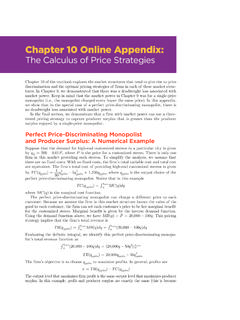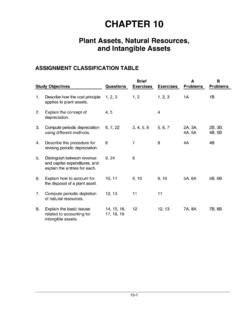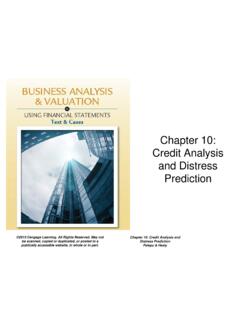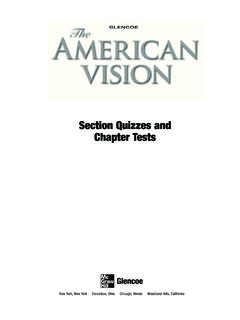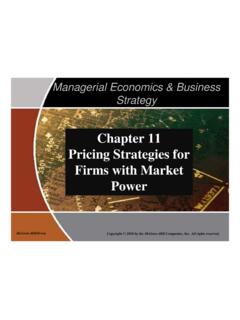Transcription of CHAPTER 11: MONOPOLISTIC COMPETITION AND …
1 CHAPTER 11: MONOPOLISTIC COMPETITION AND oligopoly introduction While perfect COMPETITION and monopoly represent the extremes of market structures, most American firms are found in the two market structures between those extremes. MONOPOLISTIC COMPETITION is very similar to perfect COMPETITION , though the firm has a small amount of market power . The oligopoly is very similar to the monopoly, though the firm does have a few competitors and the rivalry among those firms leads to an interdependent relationship among firms. CHAPTER 11 introduces these two models and explains the decision making of firms in these industries. This CHAPTER completes the discussion of the market structures, which constitute the heart of the microeconomics course. Material from CHAPTER 11 consistently appears on the AP microeconomics exam in a few multiple-choice questions and, in recent years, in free-response questions. MONOPOLISTIC COMPETITION MONOPOLISTIC COMPETITION is a market structure in which a large number of firms produce a differentiated product and firms can easily enter or exit the industry.
2 Each firm in the industry sells a very small portion of the market share and has very little market power . Firms act independently, and one firm's actions have little or no effect on the other firms. In these ways, 'the monopolistically competitive firm sounds very similar to the perfectly competitive firm. However, the key difference is product differentiation. While products are substantially the same, the firms make slight changes and then heavily advertise those differences in an effort to bring customers to their firm instead of the competing firm. One gas station may offer a car wash, while another may sell food inside the station. One dry cleaner may offer one-hour service, while another offers alterations. One motel may offer convenience to a major highway, while another offers small kitchens in the rooms. Monopolistically competitive firms are very competitive, so where does the monopoly part of the term come from? Consider how many gas stations are located within a 20-mile radius of your home.
3 Do you tend to use the same station repeatedly? Most people do because of the location, price (including discounts for using the company's card), or another feature. The market is quite competitive, but you act almost as though there's a monopoly because you keep returning to that station. As a result, the monopolistically competitive firm has a little control over the price. Due to customer brand loyalty, the firm can slightly raise the price without losing many customers. However, if the firm significantly raises its price, customers could easily change behavior to buy a substitute.. This brand loyalty also serves as a barrier to entry for new firms. New firms can easily enter a perfectly competitive industry because customers cannot distinguish which firm is producing the identical products. In MONOPOLISTIC COMPETITION , the differences between products matter. So a new firm has to not only introduce its own product but also break customers' brand loyalty to the product they are currently purchasing.
4 100 CHAPTER 11: MONOPOLISTIC COMPETITION and oligopoly Taking the EEK! Out of Economics It is very important that you make the distinction between MONOPOLISTIC COMPETITION and monopoly. The terms look similar but the markets are very different. Focus on the word " COMPETITION ," and it will help you remember that MONOPOLISTIC COMPETITION is very similar to perfect COMPETITION , except that the products are differentiated rather than identical. The monopoly is very distinctly different, as it is the only firm in the industry. Price and Output Determination for MONOPOLISTIC COMPETITION Short run profits Q, Quantity (b) Short-run losses A monopolistically competitive firm: short run and long run Quantity (e) long-run equilibrium The graph for MONOPOLISTIC COMPETITION is very similar to the monopoly. Demand is downward sloping because the firm must lower its price to sell more. Marginal revenue is below the demand curve, because when the finn reduces its price, it must reduce the price of all of the units of output.
5 As with the monopoly, a monopolistically competitive firm maximizes profit at the output where marginal cost equals marginal revenue and sets the price on the demand curve at the point directly above the point where Me MR. As was true for perfectly competitive and monopoly models, changes in costs have effects on the output and profit of the firm. If a per-unit cost (a variable cost like labor or resources or a per-unit tax) increases, marginal cost and average total cost both increase for the firm. Because marginal cost shifts up, it now crosses marginal revenue at a lower output. So the firm reduces its output and sells its product at a higher price. But also notice that the higher average total cost shifts up, leaving the firm producing at a loss in the short run until the industry adjusts. If a per-unit cost falls (from lower production costs, lower per-unit taxes, or a per-unit subsidy), the firm increases its output and sells at a lower price. The firm will also short-run economic profit until the industry adjusts.
6 If a lump sum cost (a fixed cost such as a property tax or a licensing fee) increases, only the average fixed cost and the average total cost increase. Marginal cost does not change, so output and price do not change. Because ATC increases, the firm will incur a short-run loss until the industry adjusts. Conversely, if a lump sum cost falls (from lower production costs, a lump sum tax cut, or a lump sum subsidy), the firm still will not change output or price, but the firm will enjoy short-run profit until the industry adjusts. There are important differences between the graphs for MONOPOLISTIC COMPETITION and the monopoly. First, notice that the demand and marginal revenue curves are much flatter for the MONOPOLISTIC competitor. The demand curve is more elastic in MONOPOLISTIC COMPETITION exactly because there is so much COMPETITION . It is easy for consumers to buy a competitor's product if CHAPTER 11: MONOPOLISTIC COMPETITION and oligopoly 101 the firm increases the price too much.
7 In this way, the monopolistically competitive firm begins to act more like a perfectly competitive firm. Second, while the monopolistically competitive firm may earn short-run economic profit or loss, in the long run, the firm will earn zero economic profit. If the price is higher than average total cost at the profit-maximizing output, the firm earns a profit; if average total cost is greater than the price at the profit-maximizing (or loss-minimizing) output, the firm incurs a loss. This is the same method of calculating profit or loss we have used for both the perfectly competitive firm and monopoly. The monopoly establishes complete barriers to entry to prevent competitors from entering the industry; therefore, it can sustain long-run profit. The perfectly competitive firm, on the other hand, has no barriers to entry, so other firms are enticed to enter the market when profits occur, and firms exit the industry in periods of loss. The same is true for MONOPOLISTIC COMPETITION ; the ease of entry and exit extends to the monopolistically competitive market .
8 Short-Run ProfitILoss and Long-Run Equilibrium for MONOPOLISTIC COMPETITION When a MONOPOLISTIC competitor enjoys a short-run economic profit, new firms are drawn into the industry. As the new firms enter, the demand curve for existing firms shifts to the left and becomes more elastic (flatter). This occurs because the new firms increase the total production of output, and the individual existing firms each provide a smaller portion of the total market output. Demand becomes more elastic because the increased COMPETITION allows customers to become even more sensitive to price changes. In long-run equilibrium, after adjustments are complete, the average total cost curve for the monopolistically competitive firm lies above the demand curve and then only tangentially touches the demand curve at the point above Me = MR where the price is set. When a MONOPOLISTIC competitor incurs short-run loss, some firms will leave the industry. We use the same formula we used for perfect COMPETITION and monopoly to determine whether the firm should remain in business when it incurs a loss.
9 At the loss-minimizing output (Me = MR), if the product price is equal to or higher than the average variable cost, the firm should remain in business in the short run. In that scenario, the firm is receiving enough revenue to cover all of the variable costs of producing the product and can put any additional revenues toward the fixed cost. But ifthe price is lower than the average variable cost, the firm should shut down. If one firm remains in operation while other firms leave the industry, the firm's demand curve shifts to the right and becomes less elastic. Because customers have fewer firms to choose from, the firm will enjoy a greater piece of the market and will have a little market power to raise the price. In the long run, the exit of firms from the industry reduces the loss to zero (which also means zero economic profit). Firms are no longer enticed to either enter or exit the industry, and ATe is again tangential to the demand curve at the point where price is set above the Me = MR output.
10 Taking the EEK! Out of Economics Remember that even though the firm is not earning economic profit, the firm is earning profit and paying normal profit to the entrepreneur in order to keep himlher in the industry. Economic profit is just the excess profit that causes other firms to enter the industry. When economic profit falls to zero in the long run, current producers are covering all oftheir explicit and implicit costs and will remain in business, but there is no excess profit to draw new firms into the industry. 102 CHAPTER 11: MONOPOLISTIC COMPETITION and oligopoly Efficiency and the Monopolistically Competitive Firm Monopolistically competitive finns do not achieve productive or allocative efficiency. Productive efficiency occurs when the marginal cost equals the average total cost at its minimum point and the firm is producing at its lowest average cost. In the MONOPOLISTIC COMPETITION model, marginal cost crosses average total cost at a higher output than the point where the finn maximizes profit.
